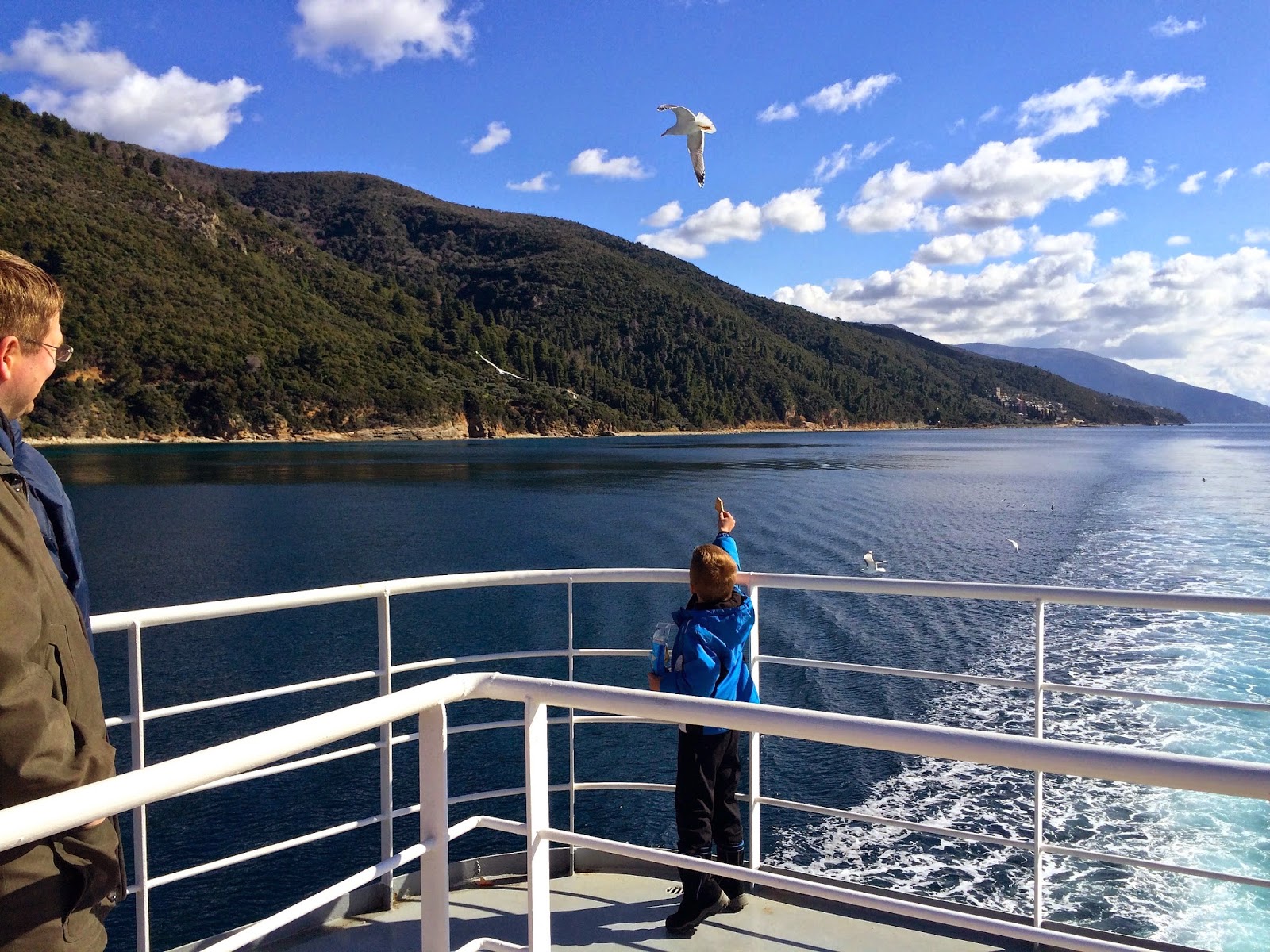Earlier in February, I had the opportunity to bring one of my boys to Mt. Athos for the first time. We went there to meet my good friend Raif, who used to live here in Portaria but has now returned to his native Germany. (We went to visit them in Hamburg last year.) It was the first time I've managed to visit Mt. Athos since moving to Portaria. (I think this must have been my last visit.) Paul and Benny decided between them that Paul would go this time, and Benny would go next time. Above you can see Paul's diamonitirion, or "visa" for entry to Mt. Athos.
Our group also included three Greek friends of Raif, as well as two of his German friends. One of the Greeks, Vasilis, has many friends on Mt. Athos, and he arranged our whole trip. Above, you can see Paul looking out the window of the boat as we passed Dochiariou Monastery.
After reaching the Athonite port of Daphne, we then took the bus up to Karyes, where we went to visit Vasilis' long-time friend, Fr. Symeon of Dionysiou Monastery, who happens to be the Agios Protos (first monk, head of the Holy Committee overseeing Mt. Athos) this year. His office is in the administrative building of Karyes, overlooking the famous Protaton church. Here you can see Paul checking out the Protaton from the door to the administrative building.
And here we are together on the stairs. Paul was being camera shy. I'm awaiting many more photos from our trip from the others.
We then headed to the Holy Cell of the Nativity of the Mother of God, also known as Marouda, which belongs to Hilandar Monastery. Like most cells on Mt. Athos, this one is headed by an elder and a small number of disciples. In this case, there is just one other monk, Fr. Paul, as well as several novices or potential novices. The elder is Fr. Makarios, who spent many years at Philotheou before taking on the project of rebuilding a dilapidated cell, as is commonly the pattern. Like many monks on Mt. Athos, he struck me as quite unique (some might say eccentric), and full of grace. His character was evident throughout the cell, which was very simple but also decorated in a lively way. Above you can see Paul next to many of the paintings that adorn the outside walls of the buildings.
Here Paul is looking out over the balcony of the guest quarters down to the small central church.
I had the blessing of the serving the Divine Liturgy there with Fr. Makarios both mornings.
Along the outside walls of the guest building is a mural with the life of Alexander the Great, apparently painted by a man from Volos who frequently visits the cell.
There was still snow on the ground in many places. Here you can see the cell's view down on the Skete of St. Andrew in Karyes. To understand more about this cell, see this very interesting article about the baptism there (on the spot where Paul is standing) of a former Taliban Afghani last year. This man, who took the name Alexander, is something like a novice there, and I had the good fortune to get to talk to him a bit.
Fr. Makarios has quite a sense of humor. Unlike many monasteries, which post serious warnings forbidding smoking (which most Greeks then ignore), Fr. Makarios has a different approach. Here the sign says: "Smoke freely and without fear. Smoking helps you lose weight and rest," picturing however a man getting sick and dying from smoking.
At one point, we took a walk around the area of Karyes. Our first stop was to the nearby monastery of Koutloumousiou. Above you can see Paul in the courtyard, just outside the katholikon.
Here we are back at the cell of Marouda. The monks loved the wild animals (especially cats) who gathered there, and so did Paul. He even shared some of his milk with them in a saucer.
Another time, we took a walk to St. Andrew's Skete. You can see the massive church and bells in the background above.
Here are some of the small "everyday" bells they use.
One of the monks took us up to the winter chapel, housing a large fragment of the skull of St Andrew the Apostle, which we had the blessing to venerate.
Finally, before leaving, we stopped again at the administrative building to say goodbye to Fr. Symeon, who had hosted us in his cell for lunch one day. As is the custom, Fr. Symeon brought out a bowl of chocolates. He then said Paul could make the second round, which he later did. You can see him getting into the Athonite spirit of hospitality above.
Although it was cold while we were there, the sun was out. On the return boat trip, we were able to spend most of the time out on the deck, where we fed the seagulls who fly alongside the boat.
For more photos, click here.
























































